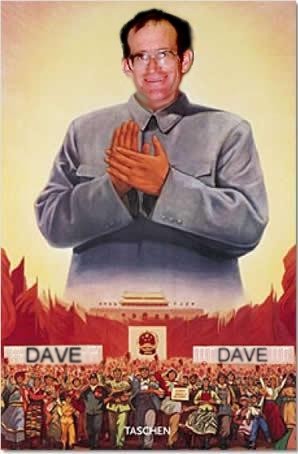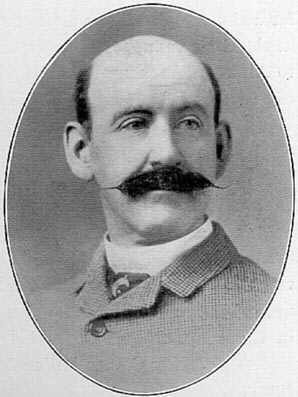


How to be America’s First Evil Dictator
by Dave Shmerson

Dave Shmerson is the writer of several informative pamphlets on the subject of knot tying for seamen as well as a mid-level party func-tionary in the People’s Republic of Mongolia and ambassador plenipo-tentiary to the Unified Nations, an alternative to the United Nations.
America is clearly in need of its first evil dictator. While Aaron Burr’s attempt was essentially stillborn and Calvin Coolidge failed completely in showing any sign of antagonistic tyranny, it is still possible for one of you to be at the forefront of fascist autocracy in America.
Here’s how: Found your political party. Complicated? Not at all. Merely register with your state elections board, then grab a bunch of friends or like-minded folks you meet at the bar, Sunday school or singles picnics sponsored by on-line dating sites. Build on this through compulsion. Nothing makes someone want to join your party more than the capture and threatened ruthless murder of close relatives. You may also wish to try poison.
With your base firmly established, you can now go on to forcefully spread the word. Ideally The Party of Evil will have catchy branding and forced ballot access in all 50 states. Target that all-important 18-24 demographic with ads touting The POE. Avoid Edgar Allen references and play on people’s fears. They won’t know what a fright they’re in for after they vote you in.
Say anything to get a vote. It may seem like politicians already do this, but they really don’t. The POE will say absolutely anything to get a vote. When cornered by journalists, threaten the lives of themselves and their families. As you can see, using the relations of those placing themselves as obstacles in your way is an important tactic in furthering your career as an evil dictator. Make sure to keep in practice with unruly grocery store clerks and perfume sprayers at department stores. You will also be spending a lot of time in grocery and department stores, but we’ll get to that later.
Spend most of your campaign money on issue ads directed at destroying the Moon. This is not only classic evil, but will draw attention to The POE and away from the two major parties. Make sure to spend Sunday mornings listing reasons why the Moon will be destroyed. Do not threaten Sunday morning commentators. They are an already prepared arm of evil and should be coddled. Whenever the “opposition” is given an opportunity to speak, interrupt, lambast and bring the conversation back to the topic of the Moon. You’ll win handily every time.
You may be asked about our interactions with international powers. Be aggressive with foreign relations. When asked policy questions, respond that our enemies will be destroyed by our grand, victorious armies. Shake your fist and vow to finish what James K. Polk started.
Criticize historic dictators whenever asked about the policies of the incumbent. Say how soft Stalin was on political opponents. Carry around a pyramid of grapefruit which demonstrates the proper way to stack skulls. Make sure to deride Pol Pot’s method. Compare yourself favourably. Threaten critical opinion writers. Send your “men” around to their houses early in the morning and late at night. They don’t have to do anything they just have to be there, though an occasional menacing glare helps. Send strange packages and have your lackeys call in bomb threats on their homes. It’s not high political manoeuvring, but it sure is fun.
Falsely identify generals and admirals as military allies. Hint at the words “junta” and “coup.” Force them to defend the ridiculous allegations, bringing you publicity. If you see any sign that their defences are being taken seriously, comment on their fair-weather attitude and lacklustre military prowess. Ask about the last time they fought a successful war.
In the week before the election, state that you’re not sure what party members will do at the polls. Tell reporters that you really have no control over what your partisans will do (you can joke about this back at the POE lounge later). Make voters feel unsafe. Post uniformed party members one foot past the legal bounds for campaign workers near polling places.
On election day, ride through a major city in the tank you bought earlier in the year. Have your face painted on the side of the war machine. Cackle a lot. Once you’ve won, immediately storm the White House and remove the current occupant. You don’t want any lame duck officer creating policy before your ascendance. Force the Chief Justice to swear you in, then have him shot. What you do with the office of President is really up to you, but remember the three keys to being a dictator.
1. Always kill the overconfident underling.
2. Make sure to eat one strange combination of foods.
3. Great uniforms.
By staff cloudberry expert Katie Stalin

Katie Stalin, the great-granddaughter of Soviet Premier Josef Stalin, has spent her life preserving her family’s legacy of terror, ruthlessness, violent purges and Five Year Plans.

Originally, this was going to be a message about the importance of cloudberries to Norwegian culture and cuisine, only I saw something which infuriated me as a human being and as one of the pedestrians of the world. Above you will find the photograph which has launched me into this tirade. What an ignorant child. What a useless youngster. How could this worthless waste of space insult the brave sailors and seamen of America’s Navy by producing such a crude and inaccurate building-block model of an aircraft carrier.
There are so many inaccuracies to contend with, I’m not even sure where to begin. Well, for starters, how about the fact that the model features the characteristic angular flight deck of a nuclear powered carrier, first introduced in 1953 in the design of the USS Antietam (CVA 36), yet the aircraft on the flight deck of this model are prop-driven planes featuring folded-wing designs characteristic of WWII Navy fighters such as the F6F Hellcat or the F8F Bearcat. Even more horridly out of place are the bi-planes, which to my knowledge have never been deployed from even an Essex-class carrier, much less a Nimitz or Kennedy class.
And I must ask “How exactly did those aircraft get from the main hangar deck to the flight deck?” By magic I guess, since this model doesn’t feature a single elevator while everyone knows that a Nimitz class carrier has four aircraft elevators. Who knows, maybe there is an elevator somewhere on this model, but if there is then it’s not very clear, just another indication of poor craftsmanship. I pray to God that no airplane ever does try to land on this deck, which features a startling lack of crash barricades, arresting wires, or a Fresnel Lens Optical Landing System.
Take a look at the island. Where are the designation numbers which would allow us to know which carrier this is? The island seems to feature only one windowed deck, which I must assume, based on the noticeable absence of the vulture’s row, that this is not the Pri-fly. So, is this one deck the bridge? The flag bridge? So bad is this model that I have no idea.
And look at the two flags atop the island where the radar and communications array should be. One appears to be either a German or gay flag, which is odd because last I checked neither the Federal Republic of Germany nor GLAAD have ever deployed an aircraft carrier. The other flag is definitely a Lego™ symbol. To assert that the LEGO Group is a military force is just stupid.
What an idiotic child. I hope his parents have the decency to take him to a library or something before he even attempts to look at plastic building block toys again.

Dr. Scott Birdseye is the Rufus Palmeroy Scholar in Pan-International Historitical Studies at the Montsylvania College of Agricultural Technology Design Arts. His menagerie includes two giraffes, a condor, twelve different species of monkey and a salamander named Clem.
Peace in Colonial Mexico City was a product of the system of social order based upon economics and racial relations. Division defined the social structure, ethnic and economic division between the ruling elite and the plebian subjects, and racial division within the plebian lower classes. As the wealthy Spanish ruling class formed only a small percentage of the population as a whole, the elite used governmental regulations and politically based legal system to maintain a high degree of official separation between the races which made up the lower classes.
Fearing for loss of control, the elite used lower class division as a means to ensure continuation of their own power and to ensure greater stability within society. Racial division and upward economic mobility, while maintaining the social order upon which the elite based their domination, also increased random, sporadic violence between racial groups in the lower classes, diminishing the effectiveness of the system for maintaining overall social order.
Colonial Mexico City was characterized by racial diversity and by a high degree of interaction and intermarriage between different ethno-linguistic groups. The early racial division concerned only Spanish and Indians, however, later institutionalized slavery defined the three main racial groups in Mexico as Africans, Spanish and Indians.
While a wide variety of racial identifications existed to distinguish people whose ancestry crossed the clearly established lines of race, initial Spanish political rulings overlooked the more complex racial identities present. Within the intermediate ethnicities there existed a lack of definitive methods of racial identification, blurring and obscuring the once clear borders of race.
In the daily life of the castas, race was not an important issue, and racial identity tended to be ascribed only by interaction with governmental institutions. Strict categorization was unnecessary in plebian life, where loyal affiliation involved family and neighborhood rather than race or class. Spaniards, both Criolo and Peninsulares were generally the only group concerned with strict records of ancestry and racial purity. Thus, it was only in these groups, which formed the elite, that exact racially identity was known.
For the plebian elements in society, fixed racial identity was unimportant, and it was common for an individuals race to change, due to both changing economic status and to the differing opinions of governmental recording agents.
Spanish distaste for the castas was common, and aversion quickly evolved into fear, fear which was amplified by the fact that the ruling elite were in the minority. The Viceroy of New Spain declared that mestizos, mulattoes and free blacks were dangerous and implemented a series of policies designed to halt social unification of the underclass. Conspiracies by Africans in 1608 and 1612 only furthered Spanish fear and desire to control the commoners. It was legally forbidden for Africans and anyone of even partial Spanish blood to take up residence in Indian villages.
Despite these ordinances, interracial socialization, particularly in Mexico City’s pulquerias and gambling dens continued. Through people of different races interacted regularly, different standards applied in the legal arena. Castas were subject to harsher laws and economic regulations than were Spaniards. Indians were still required to pay tribute, and mestizos were often subject to the Repulica de los Indios. Thus, the plebian classes had many divisions under the law, divisions which eventually evolved into de facto separations within the lower class. People of the lower classes however, continued to use the Spanish legal appeal system, illustrating a recognition of the Spanish law and its institutions.
The plebeians saw the legal distinctions as valid in many cases, and followed them as was expected under the Patron-Cliente System. The commoners viewed the rulers as their Patrons, who would protect and provide for them, and in exchange the commoners understood their obligation to obey Spanish law.In economics, like law, racial identity became a way for the elite to secure division amongst the lower classes.
Labor and types of available employment were tied to race, as Indians were still forced to provide encomienda labor and castas generally were limited by the occupations of their families. Thus, occupation provided a way to create and perpetuate separate and distinct racial identity. With the constant silver shipments to Spain, money was rare in Colonial Mexico, and what cash was available was concentrated in the hands of the elite. Accumulation of liquid assets was nearly impossible for non-Spaniards, and any wealth was in the form of land or goods. Upward social mobility, while difficult, was accomplished in Colonial Mexico through economic means, ensuring that within the non pure Spanish population racial identity could change.
Thus, while the different races were divided, within individual ethnicities, loyalty to the race was unknown, as racial identity could change through economic means. The Patron-Cliente System dominated racial mobility, as economic mobility often depended upon the willingness of the elite population. This system created an inherent instability within Mexico City’s population. Elite patrons were required, within the confines of the system, to provide economic protection for the commoners in order to insure social stability.
Food scarcity and price increases were seen by the lower class as a failure of the rulers to meet their obligations, and in such situations, the plebian masses saw obedience as unnecessary. The lower class often used the threat of riots and violence as a means to manipulating the bureaucracy to get better or fairer treatment under to law. Conditions of this sort in Mexico City in 1692 became so intolerable for the lower class that they were able to unite and, through a massive riot, threaten to terminate the rule of the elite.

Plebian unity, however, was short lived, and division within the lower classes, fuelled by racial distinctions, brought about the end of the riot and the reestablishment of the elite control. After the ferocity of the riot of 1692, the Spanish elite reiterated and expanded upon their policy of racial division as a means to ensure their own political and economic domi-nance.
In the end, internal division within the lower class made radical social or political change in Mexico an impossibility. While the system of division based upon racial identity did enable the elite to maintain their control over the political and economic systems of Colonial Mexico City, it did little to maintain peace within the city.
Personal violence and crime created by the divisions were un-abated, and riots and violence by the lower class, though unsuccessful in bringing about political and economic change, disrupted daily life and the social order within the city. In one respect the system was successful, in that it enabled the elite to maintain control, however, the elite, through their own system, failed to provide true stability and safety for the commoners in the manner of a proper Patron.
